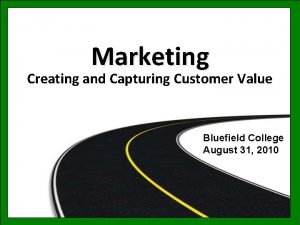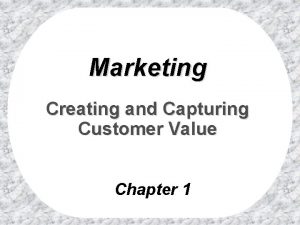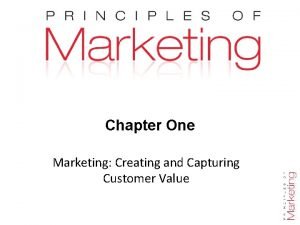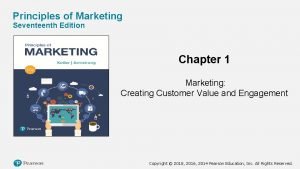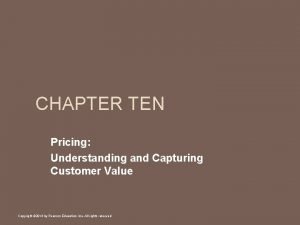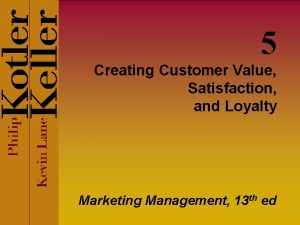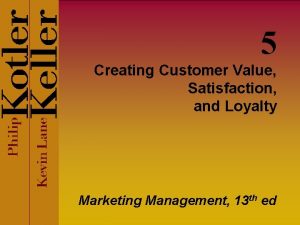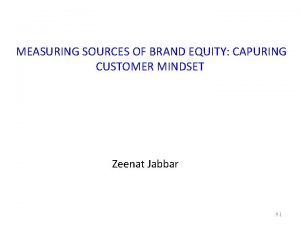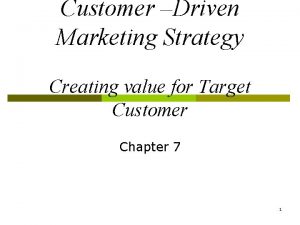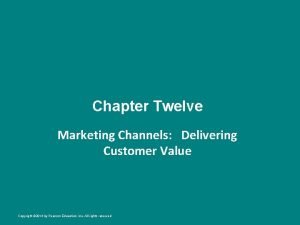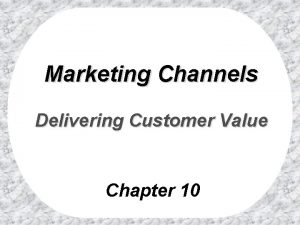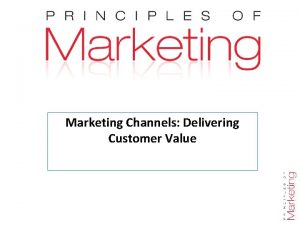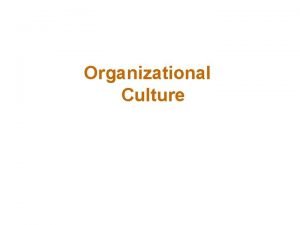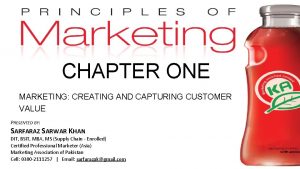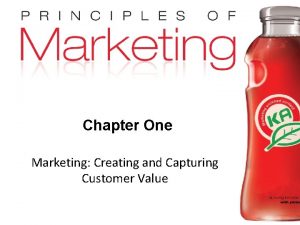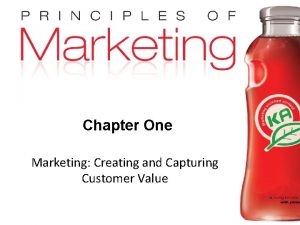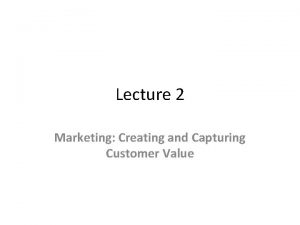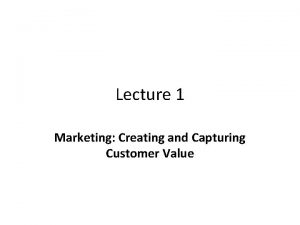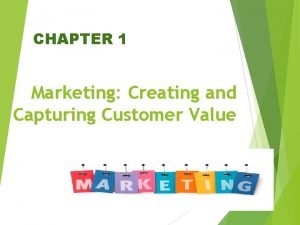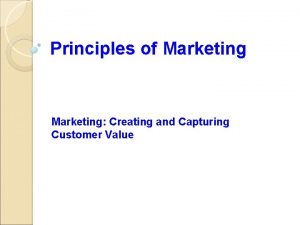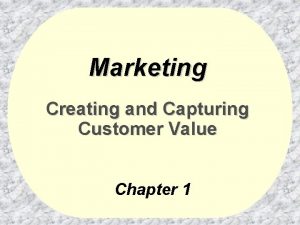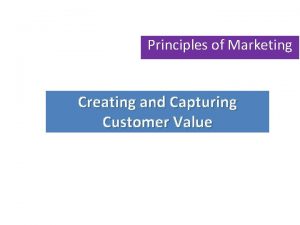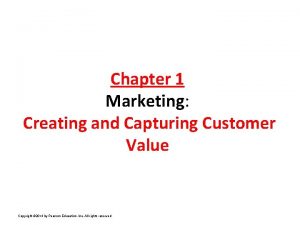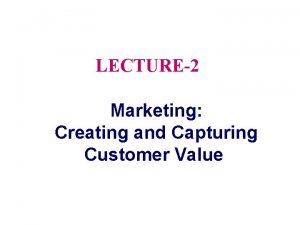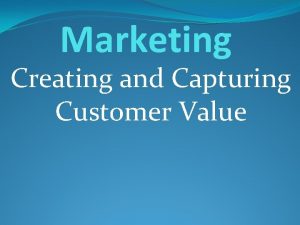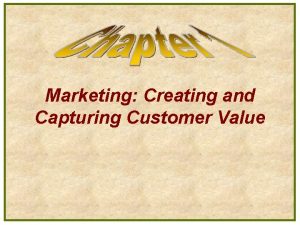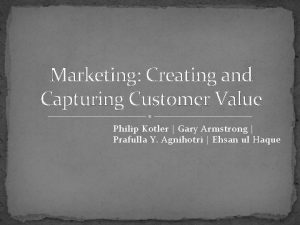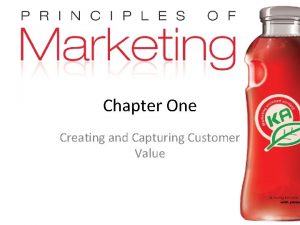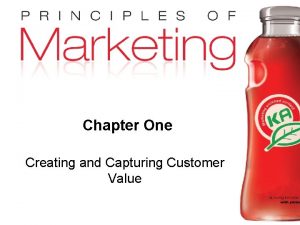Lecture One MARKETING CREATING AND CAPTURING CUSTOMER VALUE






















- Slides: 22

Lecture One MARKETING: CREATING AND CAPTURING CUSTOMER VALUE

Learning Objectives • What is Marketing • Understanding the Marketplace and Customer Needs • Designing a Customer-Driven Marketing Strategies • Preparing an Integrated Marketing Plan and Programme • Building Customer Relationships • Capturing Value from Customers • The Changing Marketing Landscape

What is Marketing? Broad definition: • A social and managerial process by which individuals and organisations obtain what they need and want through creating and exchanging value with others. Narrower business context definition: • The process by which companies create value for customers and build strong customer relationships in order to capture value from customers in return.

Understanding the Marketplace and Customer Needs • Marketers need to understand customer needs and wants and the marketplace in which they operate • The five core customer and marketplace concepts are: • 1. Needs, wants and demands, 2. market offering, 3. value and satisfaction, 4. exchange and 5. relationships and markets

Customer Needs, Wants and Demands • Human need is a state of felt deprivation of some basic satisfaction. • Wants are the form human needs take as they are shaped by culture and individual personality. • Demands are human wants that are backed by purchasing power

Market offerings: Products, Services and Experiences • Customer needs and wants are fulfilled through market offerings. • Market offerings include physical products, services, • More broadly, they includes other entities such as persons, places, organizations etc. • There is the likelihood of marketing myopia

Customer Value and Satisfaction • Customers form expectations about the values and satisfaction that the various market offerings will deliver and buy accordingly. • Satisfied customers repeat purchase and tell other about their good experiences

Exchange and Relationships • Exchange is the act of obtaining a desired object from someone by offering something in return. • Marketers want to build strong relationships by consistently delivering superior customer value

Market • A market comprises the set of all actual and potential buyers of a particular product and/or service. • We can talk of product market and brand markets. • Marketers need to manage markets to bring about profitable customer relationships. • Marketers must also deal with customermanaged relationships.

Designing a Customer Driven Marketing Strategy • The marketing strategy concepts comprises ü Selecting customers to serve ü Choosing a value proposition ü Marketing management orientations

Selecting Customers to Serve • The company must decide whom to serve? • There should be segmentation (dividing the market into segments) and • targeting (selecting which segments to serve) • Marketing management is about customer management and demand management.

Choosing a Value Proposition • A brand’s value proposition is the set of benefits or values it promises to deliver to consumers to satisfy their needs • It is what differentiates and positions one brand/company from another • Companies must design strong value propositions that give them competitive advantage.

Marketing Management Orientations • • • The Production Concept The Product Concept The Selling Concept The Marketing Concept The customer concept The Societal Marketing Concept

Preparing an Integrated Marketing Plan and Programme • The company decides the target market and how to create value for customers • Develops integrated marketing programme that actually delivers the intended value • The programme consist of the integration of the firm’s marketing mix of product, price, place and promotion • The firm blends each of these to deliver the intended value to customers

Building Customer Relationships • Understanding the marketplace and customer needs • Designing a customer-driven marketing strategy • Constructing a marketing programme • All lead to building profitable customer relationships.

Customer relationship Management (CRM) • The overall process of building and maintaining profitable customer relationships by delivering superior value and satisfaction. • Customer value is the customer’s evaluation of the differences between all the benefits and all the costs of a marketing offer relative to those of competing offers. • Customer satisfaction is the extent to which a product’s perceived performance matches a buyer’s expectations.

The Changing Nature of Customer Relationship • There is a shift from mass marketing to building deeper, more direct and lasting relationship with customers • Some important trends in the businesses and customers are relating to one another are: ü Relating with more carefully selected customers ü Relating more deeply and interactively.

Partner Relationship Management • Marketers must join hands with partners to deliver greater value to customers • In addition to being good at CRM, marketers must also be good at PRM. • Partners inside the company-every member of the firm must understand marketing and be customer focused. • Partners outside the firm: connecting with suppliers, channel members, and even competitors.

Creating Value from Customers • The outcomes of creating and delivering superior customer values by marketers include: ü Creating customer loyalty and retention by delighting customers ü Growing share of customer-through crossselling and up-selling ü Building customer equity-total combined lifetime values of all customers

Building the right relationship with the right customers Type of Customer Characteristics Type of Relationship Strangers Low profitability Little loyalty Little fit between offering and needs No investment Butterflies Profitable but not loyal Good fit between offerings and needs Short profitable business relationship, then stop investing in them True friends Profitable and loyal. Strong fit between needs and offerings Continuous relationship investment Barnacles Highly loyal but very unprofitable Limited fit between needs and offerings. Sell them more products, raising fees of reducing to them If still not profitable, FIRE them.

The Changing Marketing Landscape • The major trends and forces are: ü The uncertain economic environment ü The digital age ü Rapid globalization ü Sustainable marketing-The call for more social responsibility ü The growth of not-for-profit marketing

The End
 An expanded model of the marketing process
An expanded model of the marketing process Creating and capturing customer value
Creating and capturing customer value Creating and capturing customer value
Creating and capturing customer value Creating value and capturing value
Creating value and capturing value Marketing chapter 1
Marketing chapter 1 Pricing understanding and capturing customer value
Pricing understanding and capturing customer value Creating customer value satisfaction and loyalty
Creating customer value satisfaction and loyalty Creating customer value satisfaction and loyalty
Creating customer value satisfaction and loyalty Creating customer value satisfaction and loyalty
Creating customer value satisfaction and loyalty Measuring sources of brand equity
Measuring sources of brand equity Capturing customer mindset
Capturing customer mindset Demand measurement in marketing
Demand measurement in marketing Capturing marketing insights
Capturing marketing insights Danone
Danone What is a customer driven marketing strategy
What is a customer driven marketing strategy Chapter 12 marketing channels delivering customer value
Chapter 12 marketing channels delivering customer value Marketing channels delivering customer value
Marketing channels delivering customer value Marketing channels delivering customer value
Marketing channels delivering customer value Multi channel distribution
Multi channel distribution How organizational culture form
How organizational culture form Customer responsive culture
Customer responsive culture Apa itu value creation
Apa itu value creation 01:640:244 lecture notes - lecture 15: plat, idah, farad
01:640:244 lecture notes - lecture 15: plat, idah, farad
